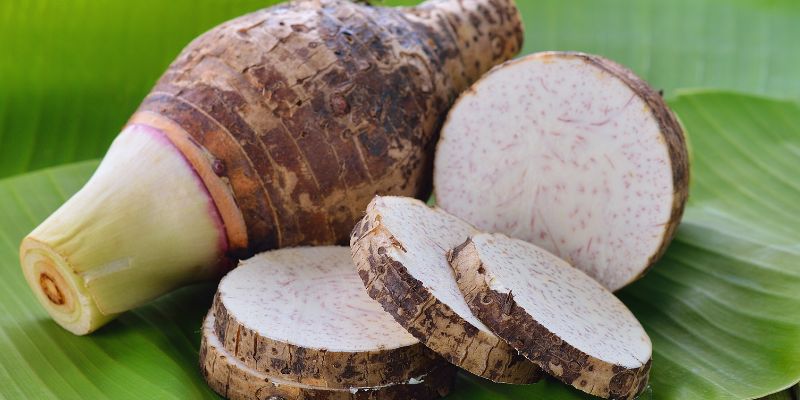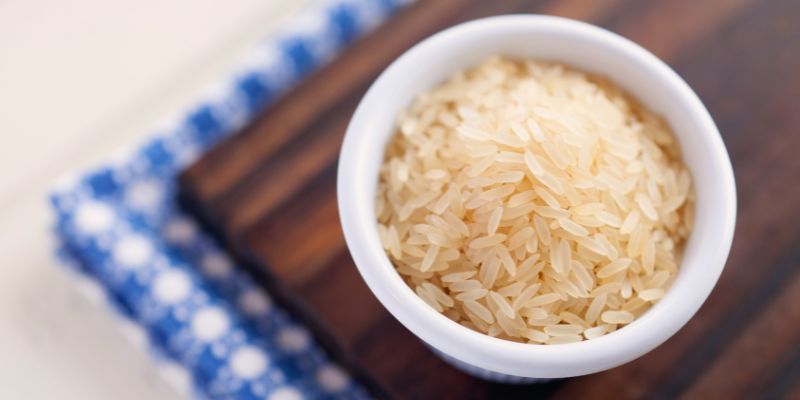Advertisement
With its abundant vitamins, minerals, electrolytes, and antioxidants, taro is a very nutritious vegetable and one of the ancient crops. Taro root is utilized in numerous cuisines worldwide. It is a healthier substitute for other root vegetables like potatoes because of its mild, nutty flavor, sticky texture, and nutritional advantages.
The vegetable has white flesh with clear purple dots and a brown outer layer. The body requires energy to stay active, and taro root is an outstanding source of energy. Additionally, it contains fiber, which is necessary for the good health of the intestines and bowels. To know more about the health benefits of taro root, read this article!

When cooked and served correctly, it can be a beneficial addition to your diet. The potential health advantages of taro root include:-
Various minerals, fiber, potassium, and magnesium, which people sometimes don't get in sufficient quantities, are present in adequate amounts in taro root. It is a great source of dietary fiber and nutritious carbohydrates, which can help you lose weight and enhance the way your digestive system works. Its high vitamin C, B6, and vitamin E content may also assist in getting rid of free radicals and support a healthy immune system. This removes toxins from your body by acting as an antioxidant.
Taro root contains fiber and resistant starch, which contribute to improved blood sugar regulation. Fiber does not affect blood sugar levels since it is not absorbed. To avoid blood sugar boosts after meals, it also aids in lowering the digestion and absorption of other carbohydrates. Additionally, taro root includes a unique kind of starch known as resistant starch, which is indigestible by humans and does not cause blood sugar levels to rise. Taro root is a wonderful carb option and resistant starch, making it beneficial for people with diabetes.
Polyphenols are substances found in taro root that have several health advantages, such as lowering the risk of cancer. Quercetin, a polyphenol present in taro roots, decreases the spread of many tumors and causes the death of cancer cells. Additionally, it is a potent antioxidant that prevents excessive damage from free radicals, which has been connected to cancer. Furthermore, certain forms of breast cancer cells were halted from spreading by taro extract.
Taro roots are naturally low in cholesterol and saturated fat, and they promote heart fitness. Taro root contains a lot of potassium, a mineral that burns excess salt and helps regulate high blood pressure. This lessens the strain on your heart, reducing the formation of long-term cardiac issues. 19% of the daily amount of vitamin E is needed to lower the risk of heart attack, which is found in taro roots. Dietary fiber intake is important for your heart health, and taro roots also provide you with a good amount of fiber.

The dietary fiber-rich meals take more time to chew and digest and can help you feel fuller for longer. Therefore, those who consume more fiber typically weigh less and have less body fat. Taro is also low in fat and rich in complex carbohydrates, which supply vital nutrients despite adding too many calories from fat. In some recipes, taro root can be used in place of higher-calorie components to help you lose weight. For instance, mashed taro can be used as a low-calorie substitute for mashed potatoes in recipes.
Vitamin C, which is necessary for the formation of white blood cells, is found in taro. White blood cells function as troops, battling viruses and germs to protect you. Additionally, it is a potent supplier of vitamin B6, which supports healthy immune function and aids in the generation of antibodies. Tarin, which is found in taro, can alter the immune response and increase immunity in both healthy and leukopenic patients. Additionally, taro root's antioxidants help the body control inflammation.
Taro root contains antioxidants like beta-carotene and cryptoxanthin, which improve vision and support overall eye health. These antioxidants mitigate the aging of eye cells, which can lead to cataracts and vision loss. It's a good idea to eat taro root for healthy eyes. Vitamin A, which is abundant in taro leaves, can help preserve vision and fight against conditions including cataracts, myopia, and night blindness.
Digestive health can be significantly improved by adding a range of high-fiber foods to your diet. Compared to potatoes, taro root contains more than twice as much fiber. Dietary fiber can reduce acid reflux, stomach ulcers, diarrhea, and constipation, and it also enhances digestive efficiency. This aids in the removal of waste products from the body and prevents them from happening again. Fiber gives stool more volume, which facilitates its rapid passage through the digestive tract.
Like sweet potatoes, taro root has a mild, sweet flavor and a starchy surface. It works well in spicy and sweet recipes. Taro roots can be roasted, cooked, steamed, pureed, and used to make cakes and curries. Taro powder, green tea, tapioca pearls, honey, sugar, and water can all be combined to create taro bubble tea, also known as taro milk tea. Additionally, you may boil it with coconut milk for an easy side dish, add it to soups or sauces, or chop it into small chunks and bake or fried to produce taro chips. Additionally, it can be eaten roasted with meats to absorb extra fat.
Taro root has a slightly sweet flavor. It is abundant in fiber, potassium, magnesium, and vitamins C and E. Taro is also a great source of resistant starch and fiber. Improved blood sugar regulation, weight loss, improved digestion, heart health, immunity, and vision are some possible advantages of taro. It's simple to prepare, so you can enjoy it in various mouth-watering cuisines.
Advertisement

By Juliana Daniel/Mar 16, 2025

By Gabrielle Bennett /Dec 10, 2024

By Triston Martin/Dec 03, 2024

By Alison Perry/Dec 04, 2024

By Celia Shatzman/Nov 05, 2024

By Aldrich Acheson/Feb 28, 2025

By Susan Kelly/Mar 17, 2025

By Verna Wesley/Dec 23, 2024

By Aldrich Acheson/Feb 28, 2025

By Christin Shatzman/Dec 08, 2024

By Noa Ensign/Nov 07, 2024

By Isabella Moss/Nov 09, 2024